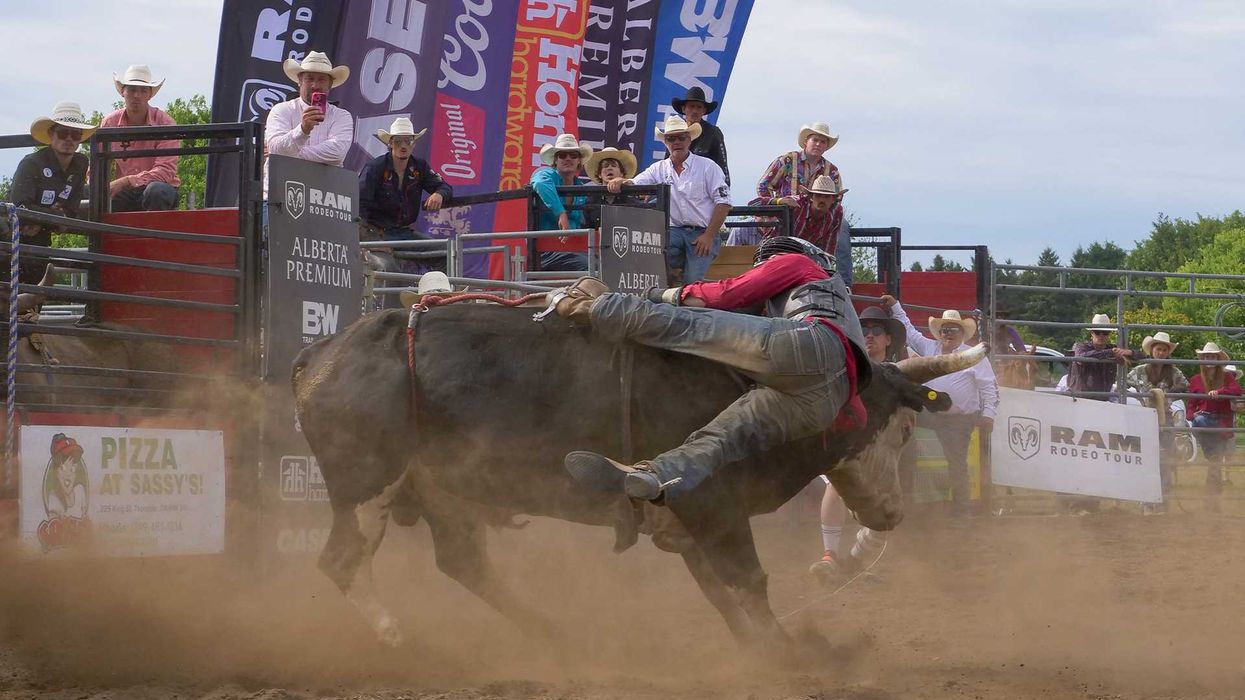
Carlo Schefter

At Purple Hill's RAM Rodeo, cowboys fight broncs, bulls, and broken bones—chasing immortality in a culture reborn from dust and danger.
At the rodeo, seven seconds feels like forever. Holding on a moment longer could mean immortality.
Mitch Walker was among the cowboys who bet on themselves to ride off to immortality at the Purple Hill RAM Rodeo in late August. Although Walker had broken his back just a few months earlier, the former bull rider appeared sufficiently vertical and smiled behind the chutes as he checked his spurs, ready to recover his entry fee and then some on a saddle bronc.
“Bull riding is a dance. Bronc riding is a boxing match,” said Walker, whose height and weight—6’2”, 220 pounds—apparently put him at a disadvantage with the bulls.
“With bull riding, you kind of got to match the moves and stick with him, stay on his back,” said the cowboy. “Versus bronc riding—I wouldn’t say you’re fighting the horse, but it’s a lot more of an aggressive riding style.”
The 16-year-old cowboy leaning on the gate beside Walker weighed in: “Bronc’s a lot harder.”
Austin Martin, set to compete in both junior bull riding and saddle bronc at the RAM Rodeo, continued: “Everything has to be right, or it’s not going at all.”
Unless they win their respective fights, cowboys and cowgirls leave the RAM Rodeo empty-handed—something the tour’s president, Ross Millar, reiterated to the hundreds of fans who had flocked that fateful Saturday to the Taylor family’s Purple Hills Farm 12 miles outside London, Ontario: “All they have is your applause.”
Walker was neither interested in conciliatory noise from the audience nor willing to have his entry fees become donations. He was after the big prize—the next of many steps on his way, he hoped, to the Calgary Stampede.
Bulls headhunt. Horses collapse. Bones are broken. Faces are reorganized.
He readied in the bucking chute over a kip (1,000 pounds of force) of bronco. Although Walker—who received a belt buckle at the RAM Rodeo last year for winning the season with the most points—swore earlier that riding now largely comes down to muscle memory, he still had to factor in that this particular horse needed extra rein, since it loves to duck its head. More rein meant less of a chance of getting pulled “up and over.”
Walker gripped the rein, then nodded to the boss. The flankman did his job, and the gateman pulled his namesake, clearing the way for Walker’s run—but the bronc didn’t want to buck.
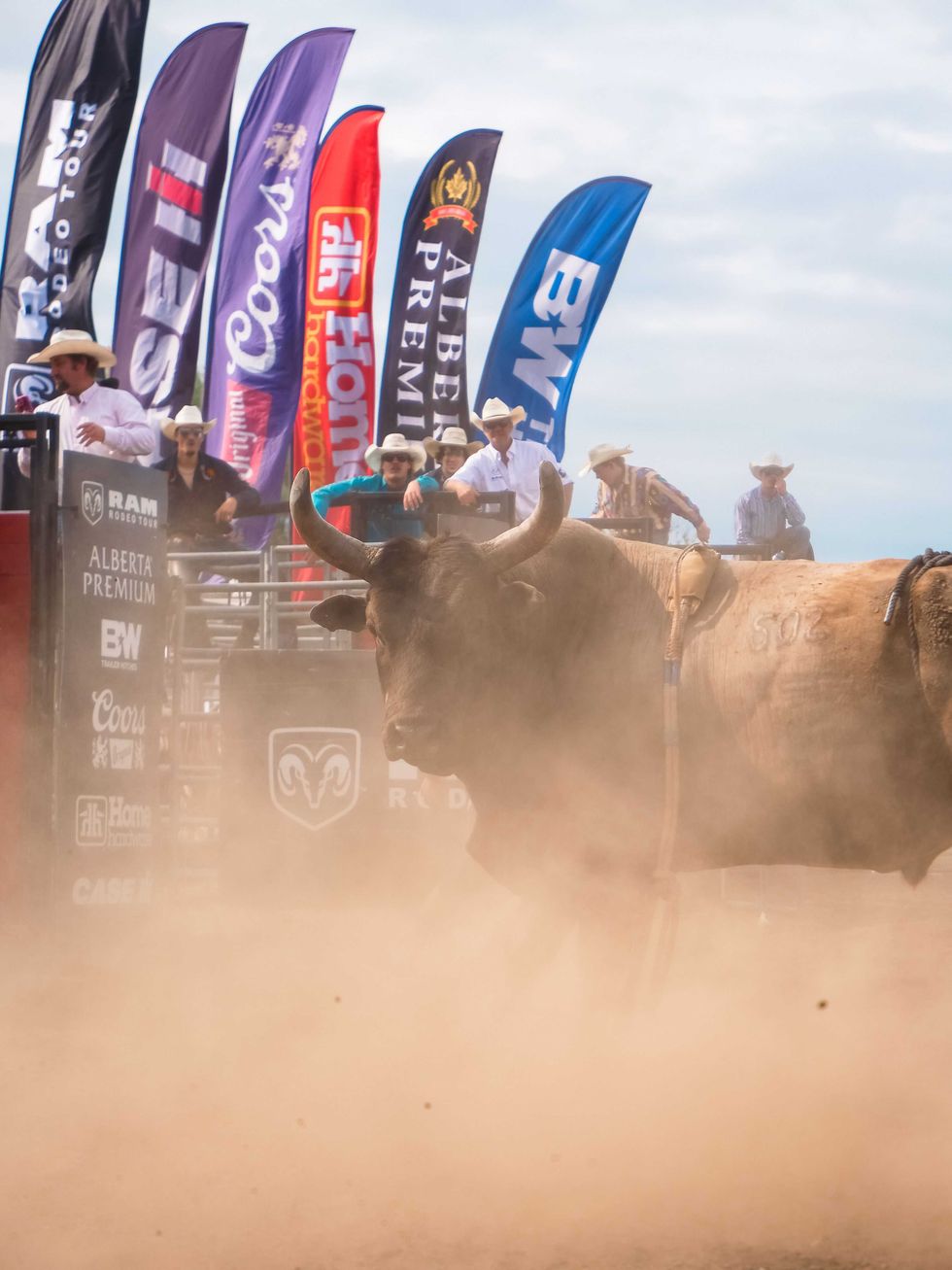
There are no second chances for a rider at fault. This half-hearted bound out of the chute was, however, a forfeit on the part of the beast. Accordingly, Mr. Millar announced that Walker would get a re-ride with a horse actually set for a boxing match.
In the meantime, young men like Martin set to work avoiding the wrong side of angry bulls, and young women channeled their will through magnificent horses in barrel racing and pole bending.
Within earshot of this theater of near-death experiences, George Taylor’s wagyu cattle cooled off in the shade of the Purple Hill Country Opry, an auction barn turned music hall some 300 yards away. Its worn walls are heavy with artifacts of country acts, and a veritable Kaw-Liga guards its boot-hammered dance floor.
Taylor, who spent part of the day cruising the premises on his lawnmower and ensuring that everyone was having fun, paused outside the Opry to field some questions about his proud inheritance.
Purple Hill has been in the Taylor family since 1853. From the first generation of Irish homesteaders onwards, the names of George Taylor’s forebears are marked on the fence posts hemming the gravel driveway in.
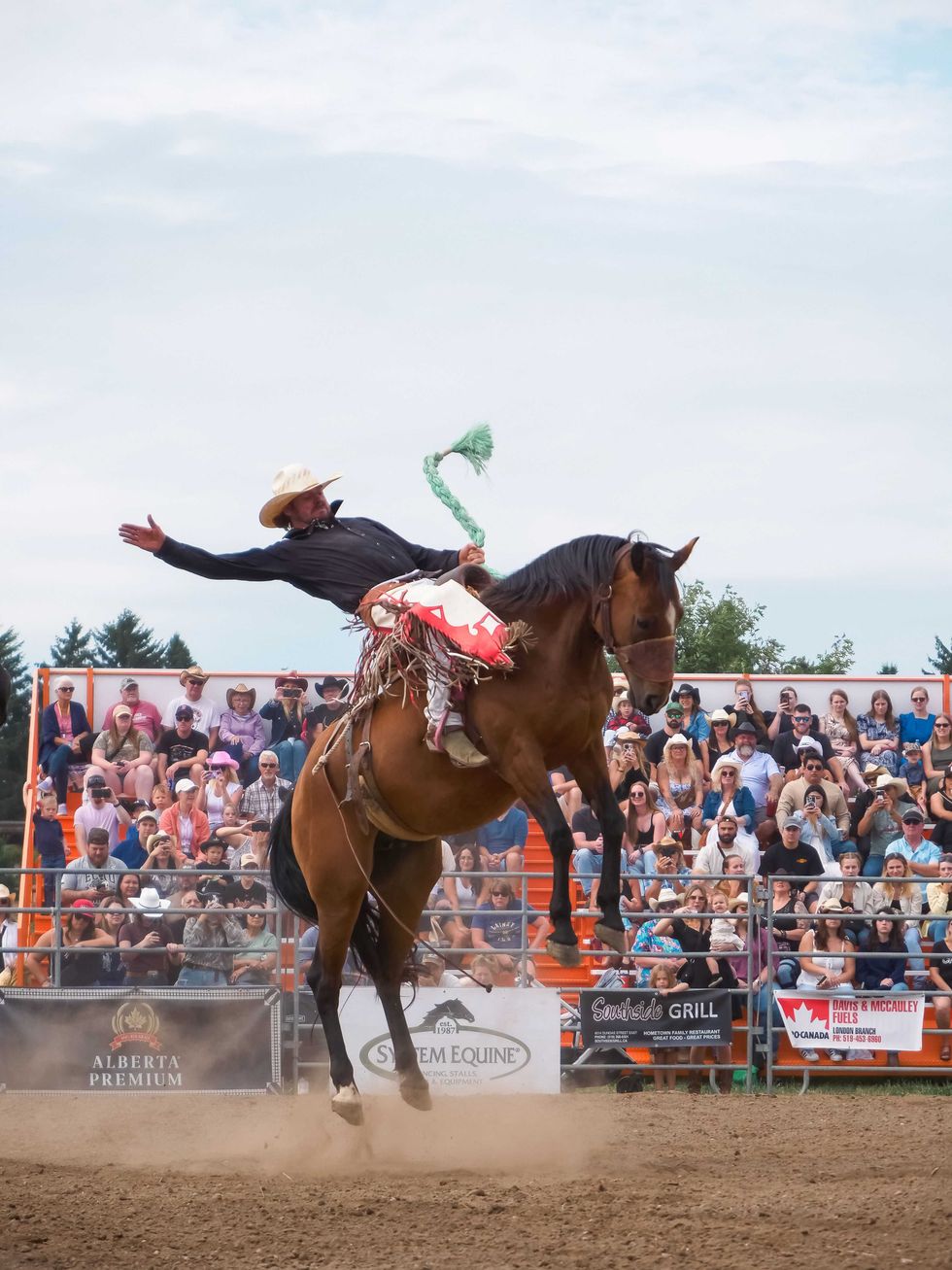
There’s been a hall of some sort at the driveway’s terminus for a long time—the Square and Compasses in the antechamber provide some indication that there was more to earlier meetings than rock and country. The rodeo, on the other hand, is a recent addition to the central 150-acre parcel. Relatively speaking, so are wagyu cattle.
Until the 1990s, Taylor and his kin were dairy farmers who collected prizes as master breeders with premier Holstein cows.
While Taylor long pursued the best in cows, he decided, four years ago, to clear some room on the farm for the best cowboys.
“Year one, I didn’t know anything at all about what was involved,” said Taylor. “We had five weeks to get ready for the rodeo, and I didn’t worry about a damn thing. It was a real good rodeo.”
We’ll have to take Taylor’s word on the quality of year one. It’s clear, however, from the staging and offerings at year four that they’ve now got it down to a science with all the fundamentals accounted for: beef, beer, broncs, bucks, and latrines. Anything else is gravy.
The timing of the rodeo’s arrival at Purple Hill was opportune to say the least. Only months prior, the province had concluded its final pandemic lockdown.
People, even those who rejected the health officials’ diktats and marched through the pandemic to the beat of their own drums, were starved for shared confrontations with “the real”—particularly the kind that comes with crowds and consequence.
That desperation was, for many, attuned to the rodeo, thanks in part to a television program that premiered in 2018.
“Thank God for Yellowstone,” Millar said with a smile. “That’s brought the whole Western culture back.”
Andrew Giangola of the Texas-based Professional Bull Riders indicated that the “Western resurgence” underway is unlike anything there’s been “since the Urban Cowboy craze of the 1970s.”
“Cowboys right now are very cool. That’s due to a combination of factors: Yellowstone, Beyoncé putting on a cowboy hat, and country music and Western fashion going mainstream,” said Giangola. “This explosion in Western culture certainly benefits the cowboy sport everyone wants to come see.”
This reconquest of the popular imagination has driven not only audiences back to the rodeo but riders as well.
Alex Vanevery, a retired bull rider who now works alongside his bull-riding son and serves as the RAM Rodeo arena director, noted, “We’re getting more and more cowboys now.”
Among the young guns is first-generation, third-year bull rider Cameron Degraaf.
People were starved for shared confrontations with 'the real'—particularly, the kind that comes with crowds and consequences.
“Everyone’s like, ‘Oh, this is so cool,’” said Degraaf. “Everyone wants to get into the sport, which is good because we want more competitors. We need rodeo to stay alive because it’s heritage, how the West was won—cowboys cowboying.”
“The older guys are going to complain that they’re not what they used to be. But neither were they to their forefathers,” said Vanevery.
While elements of the old guard might harbor some generational contempt, the young guns are by no means getting off easy.
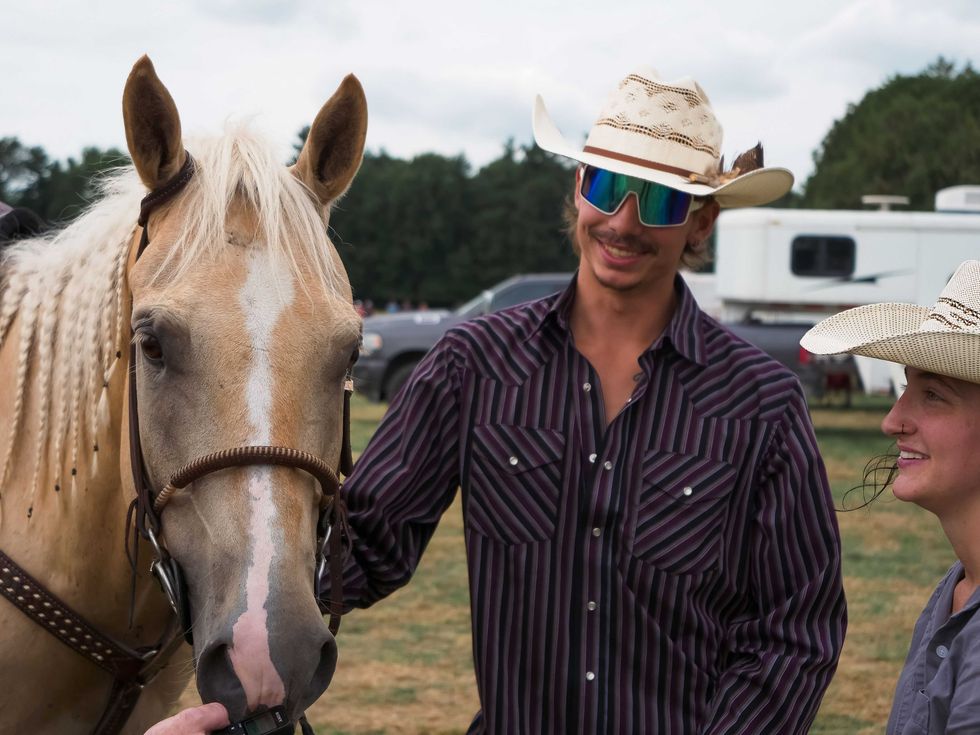
Today’s rodeo bulls and broncs are purpose-bred, meaning they’re more athletic and “more bucky.”
Giangola emphasized that bull riding as a sport is relatively unchanged: “It’s still pretty simple: a ridiculously overmatched cowboy with nothing but a bull rope in his hand and courage in his heart hanging onto an 1,800-pound bull born to buck.” However, the quality and consistency of the animals, particularly at PBR’s elite level, pose serious challenges.
“There’s not an easy bull to ride in the pen. Every single one of them is rank,” said Giangola. “That wasn’t the case 25 years ago.”
While the Western resurgence brings with it new blood and buckier breeds, the rodeo—both north and south of the border—shows no signs of changing to accommodate modern sensitivities; no signs of going soft like certain other sports where mettle was once tested and proven.
Bulls headhunt. Horses collapse. Bones are broken. Faces are reorganized.
“Most will try and keep going as long as they can, and it gets to the point where they’re just getting beat up every week. And cowboys don’t quit,” said Vanevery. “They just stop entering. And it takes everything in your person to say, ‘Okay, it’s time.’”
Walker is in the chute again, this time with a horse ready to put on a show.
The gate opens with a crack, and the bronc bursts out in a fury.
Walker’s spurs are north of the horse’s shoulders when the beast lands its first jump out of the chute, meaning it’s a qualifying start.
Dust blossoms below the beast as it unwittingly kicks itself into a violent rhythm with its rider, who extends his free hand to the heavens and racks up the points.
Walker stays on well past the eight-second mark. The horse, evidently tired of the rider’s persistence, bolts to the far side of the arena, where it throws itself back, landing right on the cowboy.
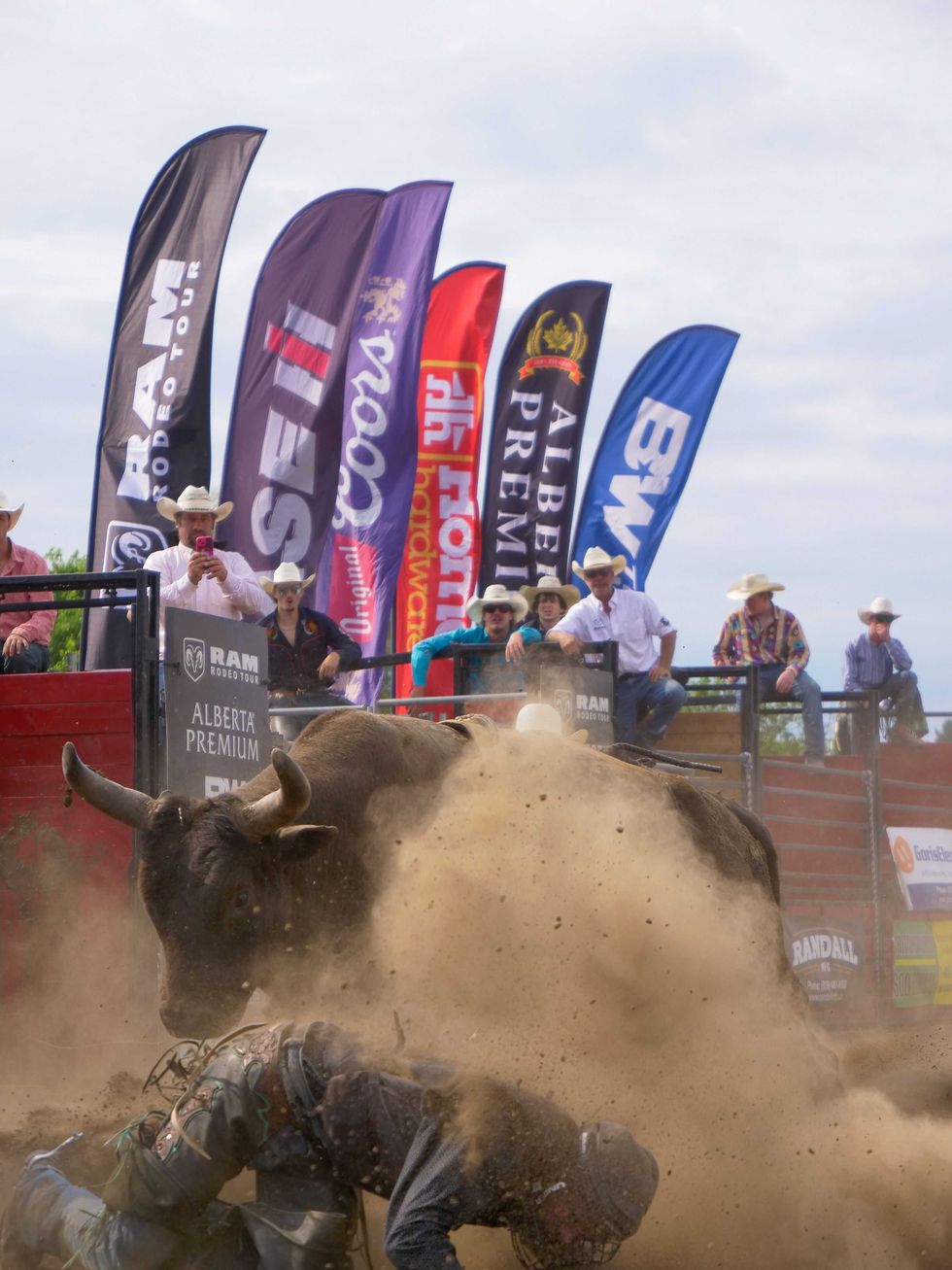
The crowd goes silent as the horse finds its footing in the brown cloud next to Walker’s motionless form. After a moment, Walker emerges from the dust, smiling.
“Any roughstock rider knows what the risk is. When you go in the bucking shoot, that could be the last time you nod your head,” said Walker. “So we go out there and accept the risk, but then we have fun doing it too. It’s like an adrenaline rush like I can’t explain to you. There’s nothing that comes close to this."
Joseph MacKinnon is a staff writer for Blaze News. He lives in a small town with his wife and sons, moonlighting as an author of science fiction.